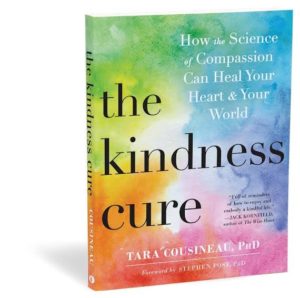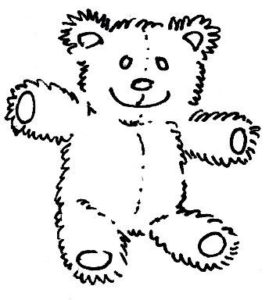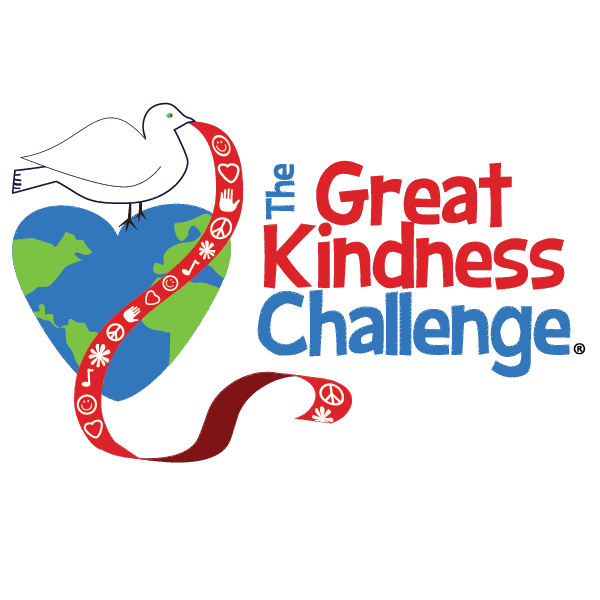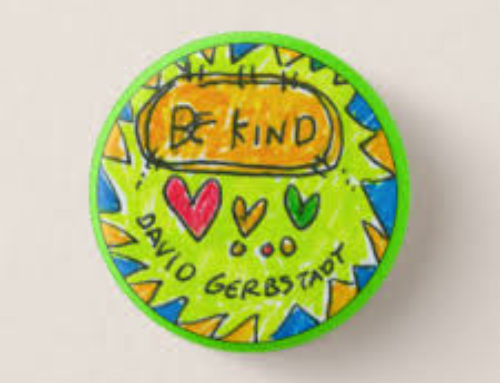
Meet Tara! Tara is a clinical psychologist and researcher by profession, and a mother, kindness warrior, and agent of change by mission. Her book The Kindness Cure (February 2018, New Harbinger Press) is a peerless book on kindness that exceeds any existing work on the subject.
Tara is an advocate for a deeper sense of our shared humanity and a practitioner of secular spirituality, with its mindfulness and practical techniques intended to elevate kindness. With the current state of the world, Tara’s work and this book are needed now, perhaps more than ever. We need to view kindness not as a “nice to have”, but as a personal and public imperative, which takes courage and effort from the inside, out.
The Kindness Cure combines wisdom, great stories, spirituality, useful tips, psychological insight, and good science with clear writing that anyone can enjoy!
Please take a moment to read Tara’s compassionate and insightful article below:

Growing a Kind Mind with Imagination
by Tara Cousineau
Outlet: The great Kindness Challenge
When word got out that I was interested in kindness, my social networks turned into kindness spotters. I was tagged on, messaged with, and e-mailed stories constantly. It became obvious that, once you look for kindness, you see it everywhere.
One viral video, Sewing Hope, hooked me completely. I watched it dozens of times, shared it, and made every kid who entered my home check it out. It is about a twelve-year-old Australian boy named Campbell who makes stuffed animals for sick children. He sews these creatures himself and, in three years, he’s given away more than eight hundred of them.
Campbell was originally inspired to buy Christmas toys for sick children, but because he has eight siblings there was no extra money for presents. Campbell’s solution? He decided to make them. He borrowed his mother’s sewing machine, even though he had no idea how to use it. He Googled patterns for stuffed animals. His first, a “little, ratty, wiggly bear” took him five hours. Many bears later, Campbell can make an animal in one hour, creating fantastical designs worthy of Jim Henson’s Creature Shop. His goal is to make one animal per day, 365 days a year.
Campbell’s mother says, “He looks at sadness and tries to turn it upside down.” He prefers sewing creatures to the usual after-school activities, such as playing video games. He can’t get enough of it. “If I say, ‘Don’t do it,’ he sneaks,” laughs his mom. In the beginning, Campbell did little jobs to earn money for fabric—until word got out on social media and people like me started making donations to cover his supplies.
Campbell visits a local children’s hospital to personally deliver the stuffed animals. He engages the children with friendliness and curiosity, which draws them out. He listens, affirms, and asks simple questions better than most psychologists or doctors with years of training. When he visited one girl being treated for brain tumors, he asked, “How are you feeling?” She answered that she was good and that her bear, Cherry Roseberry, likes to sleep a lot too. “It’s like she thinks it’s come to life,” Campbell remarked. And that’s just it—the toys he makes, when welcomed by these children, fold into their lives as companions who share their experiences.
Joyful Effort
As Sir Ken Robinson once observed, “We have evolved this powerful sense of imagination, the ability to bring to mind things that aren’t here. And from it follow all kinds of powers like creativity—and uniquely and distinctly—the power of empathy.”
Campbell’s imagination is a superpower blend of creativity and empathy. Robinson extols this kind of applied imagination —the extraordinary and entirely natural capacities of children to make creativity a practical matter, to do something with their imaginations. The creatures Campbell makes are the perfect example of what applied imagination makes possible: Campbell gets to enjoy every minute spent doing a craft, and the toys offer sweet distraction and tangible comfort to those who need them most. He loves what he is doing for others. Children offer a profound teaching: When you are engaged in a meaningful task, you are both transported and transformed by it. Your efforts are joyful.
Imaginative Empathy
The power of imagination begins in the cradle of childhood, starting with the very first objects of affection: blankies, teddy bears, dolls, pacifiers. Such objects transport us to zones of comfort; they are part of our earliest acts of creativity, imagination, and pretend play. Psychologist D. W. Winnicott called them transitional objects, and any parent or caregiver knows their importance in reducing fears of separation, along with fears more generally. Campbell knows their powers intuitively. The creative connection with objects of affection awaken an underrated aspect of empathy: fantasy. This is our ability to emotionally connect and identify with fictional characters in books, movies, and stories we make up. The link between empathy and fantasy is why two-thirds of children between three and seven years of age have imaginary companions, whether an invisible friend or a personified object.
Children love their “friends,” and even as they know the difference between what is real and make-believe, they love and bond in a way that has powerful effects. “Part of what children do with imaginary friends is practice things they are trying to figure out. Young children, especially, don’t understand friendship all that well,” says developmental psychologist Tracy Gleason. Many presume that children with pretend pals are peculiar kids living in their own worlds. But studies show that the opposite is true, as these children have a slightly larger vocabulary, are quite social, and are good at understanding the perspectives of others. “With imaginary companions, children will talk about the things they do together, or what they both enjoy doing, or how sometimes their companion doesn’t want to play. They’re trying to understand: What does it mean when somebody doesn’t want to play with you? What does it feel like to be rejected? That’s a lot of stuff to figure out!”
This doesn’t end in early childhood. Teenagers commonly have imagined relationships with celebrities or media figures, called parasocial relationships. “Say you’re fourteen,” says Gleason. “In your mind, you’re very close friends with Jennifer Lawrence. Of course, you know it’s not real. It’s totally one way. You read a lot about her. You watch all her stuff. You get online and you check out all the social media about her. You even go through life thinking, ‘What would Jennifer do in this situation?’ It’s like using her as a sounding board for your own choices.”
Imagination even helps adults work through issues. A classic cinematic example is Tom Hanks’s character in the movie Cast Away. His volleyball, Wilson, saved him from loneliness and despair, and preserved his will to live. Just like your children, you can also imagine a kindred spirit for yourself, one you can communicate with and receive guidance from. In this way, imagination makes empathy and kindness, for yourself and others, easier to practice.
Kindness in Practice: Imagining Friendly Comfort and GuidanceAs a parent, think about your life with a child’s mind. Do you cling to sacred objects such as photos, rosary beads, jewelry, an old sweatshirt, or treasured mementos that connect you to people you love? These objects of affection fill the imagination and are bound up with sensations, emotions, thoughts, and memories. You can create these associations on purpose by imbuing an object—a stone, feather, or statue, for instance—with comfort, love, kindness, and wisdom. Even though you are an adult, you can still use the wonders of imagination to befriend yourself and you can nurture the power of imagination in your children. This is especially helpful when you witness your child facing challenges in growing up or if you are recovering from your own disappointments. We all need a kind and wise friend looking after us, especially one that comes from within. The following visualization script is one you can read silently to yourself or read aloud to a child, like a bedtime story.
Begin by sitting in a comfortable position with a straight back in a posture of strength, grace, and dignity. Or you may lay down comfortably yet awake. You may close your eyes if you like. Start to relax. Take a few deep breaths, soften any tension, allow your mind to become quiet, and continue with relaxed and natural breathing.
Visualize that you are walking inside a special place where you feel peaceful, content, and safe. You may prefer a fort, a tree house, a quiet cabin in the woods, a perch on a mountainside, or a cave. When you feel ready, invite a kind and wise friend to join you. Let this wise friend’s natural form surface, however it appears. It could be a person from the past such as a grandparent, mentor, or teacher. You could imagine a friendly religious figure, a deity, an angel, a superhero, or a power animal. You might simply feel a presence, see a bright light, or feel the comfort of a warm blanket.
Allow a wise and friendly being to approach, who knows you well, who has always known you in some way. Feel that this companion cares for you and accepts you completely. You trust and respect this wise friend who cares about you. Bring to mind a question or problem that you are facing. Ask your companion for help. Listen patiently for an answer, allowing your wise friend to communicate with you in whatever way is natural. Words may come. Perhaps you will sense the answer. Or your wise friend might guide you on a vivid imaginative adventure. Be open and curious. What do you see? What kind advice do you hear? What helpful super power might you take on? Take it all in for a few minutes.
Thank your friend and imagine how you might use your companion’s wisdom. Think about what obstacles might get in the way. Consider what actions would be helpful for you and for others, even those you may be concerned about or who are bothering you. Return by visualizing your imaginary place, feeling safe and comfortable. Know that you can call on your wise friend whenever you need guidance. In your mind’s eye, begin to leave the scene and return to the room you are in. Gently open your eyes.
Recall what was meaningful to you or talk over with your child what they imagined. Parents can take out a journal for reflection and notice any new insights. In reading this visualization to a child, take into consideration words he or she will understand, or suggest a comforting statement or kind words from the wise friend and insert into the script:
“Everything’s going to be alright.”
“You’ve got this.”
“You are perfectly imperfect.”
“‘You are so loved.”
Your child may like to use paper and crayons to draw the scene. It can be helpful to have a drawing of the wise friend or helpful words on the wall.
Ralph Waldo Emerson said, “Be silly. Be honest. Be kind.” Parents can tap the power of their childlike imagination and nurture it in their children. Use your natural inclination for play and creativity to cultivate tender awareness. Like Campbell’s stuffed animals, an imaginary companion can be an object of affection and evoke feelings of goodwill, friendship, and care. At any moment, you can invite your companion to hold your hand, walk at your side, sit nearby, and share advice, comfort, and encouragement. As Campbell said, “I think being kind and not mean will change the world”—and it all starts with your wild imagination.
What an inspiring story, reminder and article, Tara – thank you! To learn more about her new book, The Kindness Cure, (February 2018, New Harbinger Press) and check out her Kindness Quotient quiz.
YOU too can make a difference with your own kind acts of kindness! To continue the kindness, please join The Great Kindness Challenge – Family Edition to engage your household in intentional kind acts, delivering a special gift to a child in the hospital! To learn more, please visit The Great Kindness Challenge!






Leave A Comment